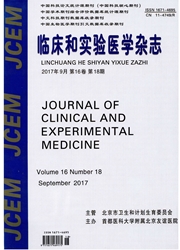

 中文摘要:
中文摘要:
目的应用定量聚合酶链反应(PCR)方法测量端粒长度。方法随机选取63例健康人外周血样本,采用定量PCR方法测量端粒长度相对T/S比率、DNA印迹法测定端粒限制性片段(TRF)长度并进行相关性分析。结果定量PCR测量端粒长度相对T/S比率为0.76±0.27,DNA印迹法测量平均TRF值为9.20±1.12,两种方法测量的结果相关性分析R^2=0.575,P〈0.01。结论采用定量PCR方法测量端粒长度具有重复性好、省时、简便、可靠,可高通量的处理大量样品的特点,端粒的长短同癌症的发生有密切联系。本方法值得推广应用于癌症的遗传学和分子流行病学研究。
 英文摘要:
英文摘要:
Objective Real - time quantitative PCR has been applied for measurement of telomere length. Methods Sixty - three samples of peripheral blood from healthy individuals were randomly selected for study. The relative T/S ratio of telomere length was measured by real - time quantitative PCR technique. The terminal restriction fragment (TRF) length of telomere DNA was measured by Southern blotting. The correlation between result of relative T/S ratio and mean TRF length was analyzed. Results The mean relative T/S ratio of telomere length was 0.76 ± 0.27 and the mean TRF length was 9.20 ± 1.12. The value of relative T/S ratio of telomere length was positively correlated with mean TRF length ( R^2 = 0. 575, P 〈 0.01 ). Conclusion Real - time quantitative PCR has advantages of simplicity and rapidity and it is readily scalable to achieve a high throughput of samples. This method will facilitate the investigations on biology of telomeres and it plays an important role in study of molecular pathogenesis of cancer.
 同期刊论文项目
同期刊论文项目
 同项目期刊论文
同项目期刊论文
 期刊信息
期刊信息
